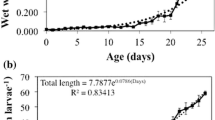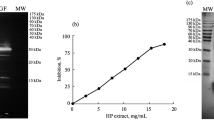Abstract
The spectrum of proteinases and the dynamics of proteinase activity in the ambulacrum structures were studied by quantitative gel zymography in the holothurians Eupentacta fraudatrix and Cucumaria japonica under normal conditions and after transverse cutting of the ambulacrum. Proteinases with gelatinolytic activity were detected only in E. fraudatrix; the species had two pools of proteinases. The high-molecular-weight pool was represented by only one (132 kDa) or two (132 and more than 250 kDa) proteins; the low-molecular-weight pool included two proteins with molecular weights of 53 and 47 kDa. In their ability to lyse gelatin, but not casein, and in their sensitivity to inhibitors of different classes of enzymes, gelatinases of E. fraudatrix are similar to vertebrate matrix metalloproteinases. It was shown that the activity of proteinases increased after injury to the animal and that GM6001, a selective inhibitor of metalloproteinases, blocks the proteinase activity. It was suggested that proteinases with gelatinolytic activity are a key factor of regeneration in holothurians.







Similar content being viewed by others
REFERENCES
Dolmatov, I.Yu. and Mashanov, V.S., Regeneratsiya u goloturii (Regeneration in Holothurians), Vladivostok: Dal’nauka, 2007.
Korotkova, G.P., Regeneratsiya zhivotnykh (Regeneration of Animals), St. Petersburg: S.-Peterb. Univ., 1997.
Solov’eva, N.I., Matrix metalloproteinases and their biological functions, Russ. J. Bioorg. Chem., 1998, vol. 24, no. 4, pp. 217–226.
Angerer, L., Hussain, S., Wei, Z., and Livingston, B.T., Sea urchin metalloproteases: a genomic survey of the BMP-1/tolloid-like, MMP and ADAM families, Dev. Biol., 2006, vol. 300, pp. 267–281.
Antczak, C., Radu, C., and Djaballah, H., A profiling platform for the identification of selective metalloprotease inhibitors, J. Biomol. Screening, 2008, vol. 13, no. 4, pp. 285–294.
Barrett, A.J., Fluorimetric assays for cathepsin B and cathepsin H with methylcoumarylamide substrates, Biochem. J., 1980, vol. 187, pp. 909–912.
Carlson, B.M., Tissue engineering and regeneration, in Principles of Regenerative Biology, Carlson, B.M., Ed., New York: Academic, 2007, pp. 259–278.
Dolmatov, I.Yu., Afanasyev, S.V., and Boyko, A.V., Molecular mechanisms of fission in echinoderms: Transcriptome analysis, PloS One, 2018, vol. 13, art. ID e0195836. https://doi.org/10.1371/journal.pone.0195836
Dolmatov, I.Y., Eliseikina, M.G., Ginanova, T.T., et al., Muscle regeneration in the holothurian Stichopus japonicus, Roux’s Arch. Dev. Biol., 1996, vol. 205, pp. 486–493.
Dolmatov, I.Y. and Ginanova, T.T., Muscle regeneration in holothurians, Microsc. Res. Tech., 2001, vol. 55, pp. 452–463.
Dolmatov, I.Y., Mashanov, V.S., and Zueva, O.R., Derivation of muscles of the Aristotle’s lantern from coelomic epithelia, Cell Tissue Res., 2007, vol. 327, pp. 371–384.
Dolmatov, I.Yu., Shulga, A.P., Ginanova, T.T., et al., Metalloproteinase inhibitor GM6001 delays regeneration in holothurians, Tissue Cell, 2019, vol. 59, pp. 1–9.
Dulley, J.R. and Grieve, P.A., A simple technique for eliminating interference by detergents in the Lowry method of protein determination, Anal. Biochem., 1975, vol. 64, no. 1, pp. 136–141.
Franco, C.F., Santos, R., and Coelho, A.V., Exploring the proteome of an echinoderm nervous system: 2-DE of the sea star radial nerve cord and the synaptosomal membranes subproteome, Proteomics, 2011, vol. 11, no. 7, pp. 1359–1364.
Hao, J.-L., Nagano, T., Nakamura, M., et al., Effect of galardin on collagen degradation by Pseudomonas aeruginosa, Exp. Eye Res., 1999, vol. 69, no. 6, pp. 595–601.
Huxley-Jones, J., Robertson, D.L., and Boot-Handford, R.P., On the origins of the extracellular matrix in vertebrates, Matrix Biol., 2007, vol. 26, pp. 2–11.
García-Arrarás, J.E. and Greenberg, M.J., Visceral regeneration in holothurians, Microsc. Res. Tech., 2001, vol. 55, pp. 438–451.
Knäuper, V. and Murphy, G., Methods for studying activation of matrix metalloproteinases, in Matrix Metalloproteinase Protocols, Clark, I., Ed., Methods in Molecular Biology (Methods and Protocols), vol. 622, Totowa, N.J.: Humana Press, 2010, pp. 233–243.
Kruger, N.J., The Bradford method for protein quantitation, in The Protein Protocols Handbook, Walker, J.M., Ed., Springer Protocols Handbooks, Totowa, N.J.: Humana Press, 2009, pp. 17–24.
Lamash, N.E. and Dolmatov, I.Yu., Proteases from the regenerating gut of the holothurian Eupentacta fraudatrix, PLoS One, 2013, vol. 8, art. ID e58433. https://doi.org/10.1371/journal.pone.0058433
Mashanov, V.S., Zueva, O.R., and García-Arrarás, J.E., Transcriptomic changes during regeneration of the central nervous system in an echinoderm, BMC Genomics, 2014, vol. 15, art. ID 357. https://doi.org/10.1186/1471-2164-15-357
Nagase, H., Matrix metalloproteinases, in Zinc Metalloproteases in Health and Disease, Hooper, N.M., Ed., Boca Raton, Fla.: CRC, 1996, pp. 173–224.
Olson, M.W., Bernardo, M.M., Pietila, M., et al., Characterization of the monomeric and dimeric forms of latent and active matrix metalloproteinase-9: Differential rates for activation by stromelysin 1, J. Biol. Chem., 2000, vol. 275, pp. 2661–2668.
Page-McCaw, A., Ewald, A.J., and Werb, Z., Matrix metalloproteinases and the regulation of tissue remodelling, Nat. Rev. Mol. Cell Biol., 2007, vol. 8, pp. 221–233.
Pasten, C., Rosa, R., Ortiz, S., et al., Characterization of proteolytic activities during intestinal regeneration of the sea cucumber, Holothuria glaberrima, Int. J. Dev. Biol., 2012, vol. 56, pp. 681–691.
Pinsino, A., Roccheri, M.C., and Matranga, V., Manganese overload affects p38 MAPK phosphorylation and metalloproteinase activity during sea urchin embryonic development, Mar. Environ. Res., 2014, vol. 93, pp. 64–69.
Ribeiro, A.R., Barbaglio, A., Oliveira, M.J., et al., Matrix metalloproteinases in a sea urchin ligament with adaptable mechanical properties, PloS One, 2012, vol. 7, art. ID e49016. https://doi.org/10.1371/journal.pone.0049016
Sawada, T., Oofusa, K., and Yoshizato, K., Characterization of a collagenolytic enzyme released from wounded planarians Dugesia japonica, Wound Repair Regener., 1999, vol. 7, pp. 458–466.
Snoek-van Beurden, P.A.M. and Von den Hoff, J.W., Zymographic techniques for the analysis of matrix metalloproteinases and their inhibitors, BioTechniques, 2005, vol. 38, no. 1, pp. 73–83.
Springman, E.B., Angleton, E.L., Birkedal-Hansen, H., and Van Wart, H.E., Multiple modes of activation of latent human fibroblast collagenase: evidence for the role of a Cys73 active-site zinc complex in latency and a “cysteine switch” mechanism for activation, Proc. Natl. Acad. Sci. U. S. A., 1990, vol. 87, pp. 364–368.
Sun, L., Chen, M., Yang, H., et al., Large scale gene expression profiling during intestine and body wall regeneration in the sea cucumber Apostichopus japonicus, Comp. Biochem. Physiol., Part D: Genomics Proteomics, 2011, vol. 6, pp. 195–205.
Woessner, J.F., Jr., Matrix metalloproteinases and their inhibitors in connective tissue remodeling, FASEB J., 1991, vol. 5, pp. 2145–2154.
Yamamoto, M., Tsujishita, H., Hori, N., et al., Inhibition of membrane-type 1 matrix metalloproteinase by hydroxamate inhibitors: An examination of the subsite pocket, J. Med. Chem., 1998, vol. 41, no. 8, pp. 1209–1217.
Yan, L., Leontovich, A., Fei, K., and Sarras, M.P., Jr., Hydra metalloproteinase 1: A secreted astacin metalloproteinase whose apical axis expression is differentially regulated during head regeneration, Dev. Biol., 2000, vol. 219, pp. 115–128.
ACKNOWLEDGMENTS
The authors express their sincere thanks to Dr. I. Yu. Dolmatov (Zhirmunsky National Scientific Center of Marine Biology, Far Eastern Branch, Russian Academy of Sciences) for his help in performance of the experiments, for participation in discussions of the results, and constant attention to our work.
Funding
This work was supported by the Russian Foundation for Basic Research, grant no. 20-04-00574.
Author information
Authors and Affiliations
Corresponding author
Ethics declarations
Conflict of interests. The authors declare that they have no conflict of interest.
Statement on the welfare of animals. All applicable international, national, and/or institutional guidelines for the care and use of animals were followed.
Additional information
Translated by I. Barsegova
Rights and permissions
About this article
Cite this article
Shulga, A.P., Lamash, N.E. Proteinases with Gelatinase Activity and their Role in Ambulacrum Regeneration in Holothurians Eupentacta fraudatrix (D’yakonov and Baranova, 1958) and Cucumaria japonica (Semper, 1868) (Echinodermata: Holothuroidea). Russ J Mar Biol 46, 461–471 (2020). https://doi.org/10.1134/S1063074020060097
Received:
Revised:
Accepted:
Published:
Issue Date:
DOI: https://doi.org/10.1134/S1063074020060097




